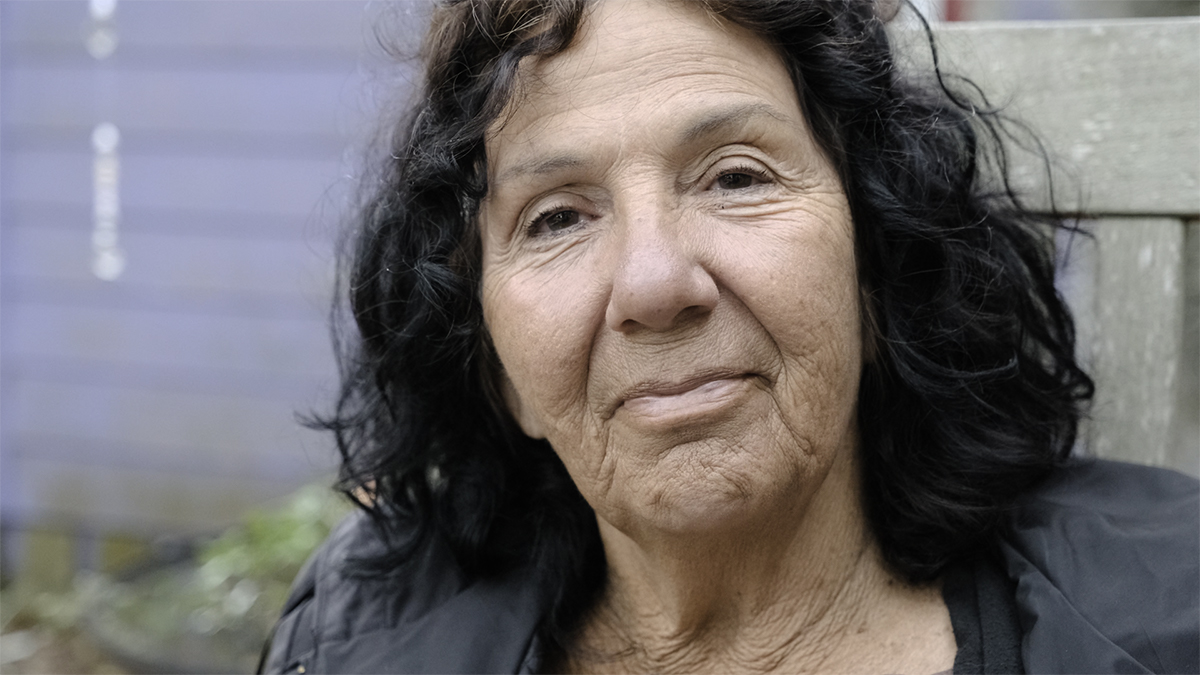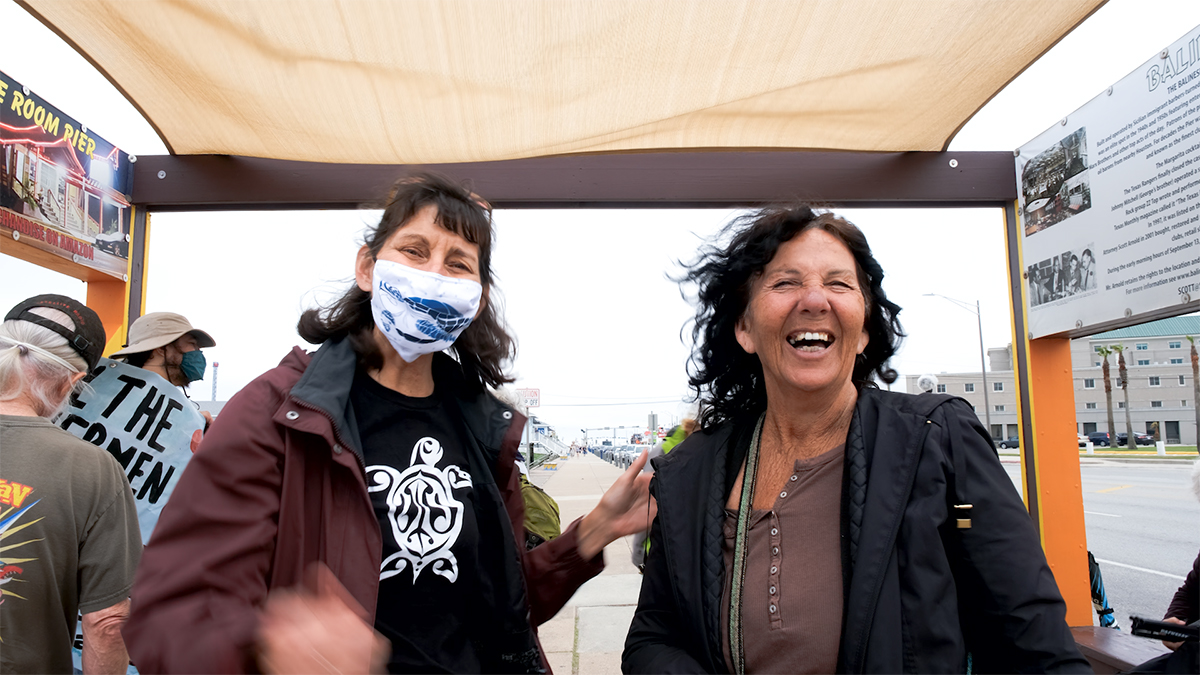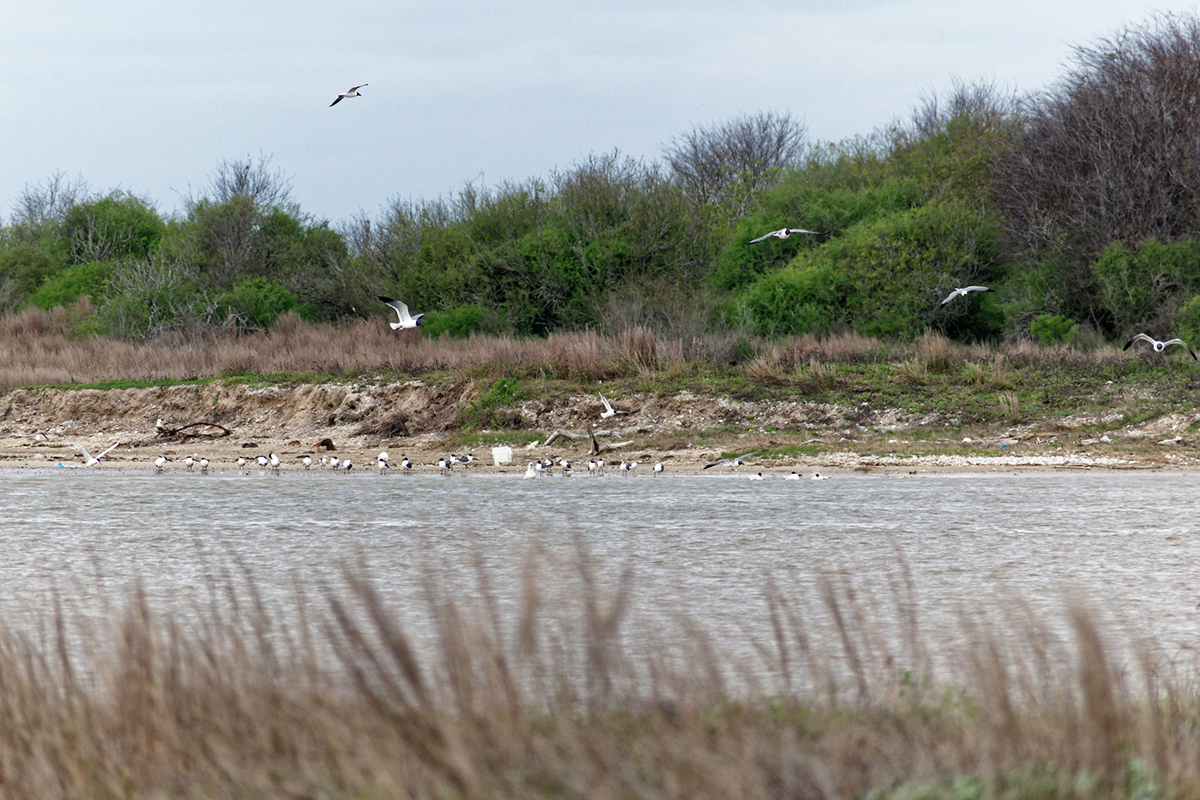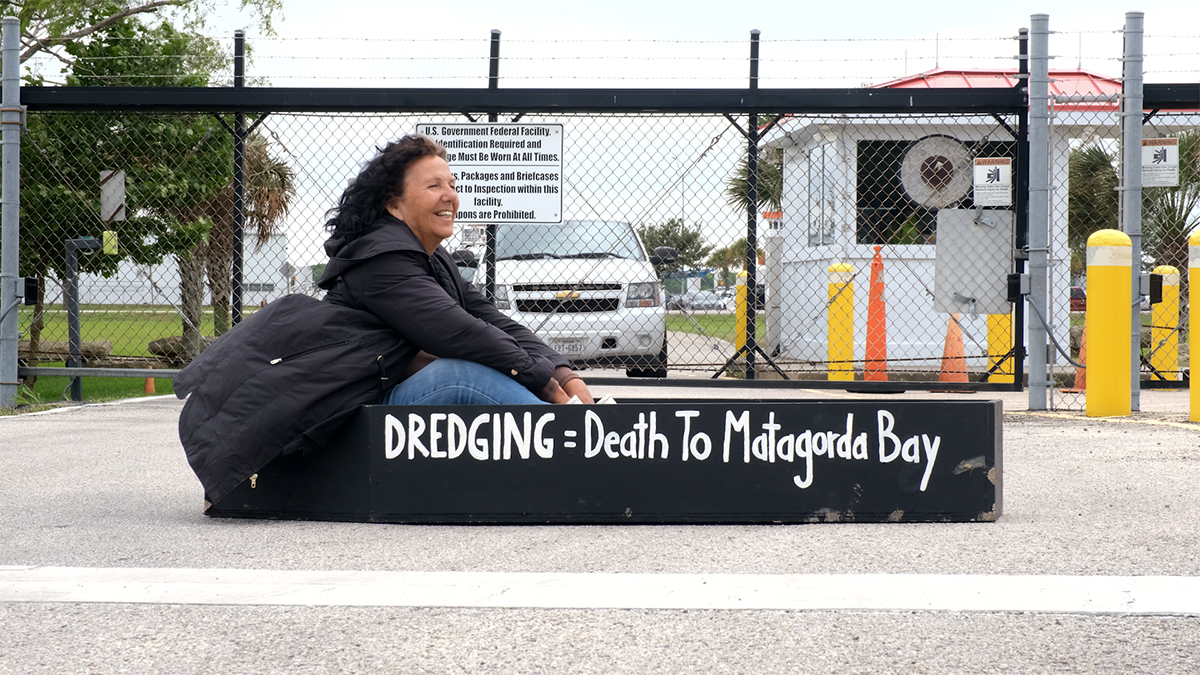The Slick
‘Hellcat’ v. Big Oil: How a Great-Grandmother Is Fighting to Protect a Texas Fishing Bay
Plans to dredge a fragile Gulf Coast estuary and Superfund site are being ‘fast-tracked’ in a rush to export Permian oil to Europe

Environmentalists, including a 72-year-old great-grandmother dubbed a “hellcat,” are up in arms over the planned expansion of an oil export terminal along the Gulf Coast in Texas.
The project would deepen a 26-mile shipping channel through Matagorda Bay to the Port of Calhoun. It would also expand and redredge the port docking and turning area to make room for larger crude oil tankers — in a bay where locals are trying to revive a decimated shrimping, fishing and oystering industry.
Co-published by Patch
During the 1960s and 1970s, a neighboring Alcoa plant dumped mercury into the bay, and in 1988 waters around the plant and port were closed to fishing. Now, locals say the U.S. Army Corps of Engineers is fast-tracking a project that would disturb sediment anchoring that toxic mercury to the bay bottom.
Join our email list to get the stories that mainstream news is overlooking.
Sign up for Capital & Main’s newsletter and get more stories like this in your email.
Last fall, Max Midstream, a pipeline company incorporated a year earlier, announced plans to expand oil export operations at the port as part of a larger project to tap into record amounts of oil being pumped out of places like the Permian Basin. The Army Corps studied plans for port expansion as early as 2000, but since Max Midstream announced its intent to turn the port into its international shipping hub, the federal agency has picked up the pace.
“They are pushing it through as hard as they can,” says Diane Wilson, a former shrimper who protested the plans with a hunger strike beginning in early April.
Those plans are possible because of a 2015 law signed by the Obama-Biden administration lifting a decades-long limit on American petroleum exports. That law has spurred increased production — including in the Permian — and opened markets outside of the United States.
But questions remain about the project’s background and planning. Max Midstream did not return repeated calls for comment on this story. Calhoun Port Authority Director Charles R. Hausmann referred all questions — including those about port operations — to the Army Corps of Engineers. The Army Corps responded only to written questions. Follow-up questions were not answered by publication time.
* * *
“I started shrimping with my dad properly when I was 8 years old,” Wilson says. She loves shrimp, but laid off eating them earlier this spring for her hunger strike.
For over a month, Wilson drove her pickup truck east across the bridge connecting residential Port Lavaca with industrial Port Comfort on the other side of the bay, pulling off the road where the bridge lands between a plastic factory and the old aluminum plant, plunking a beach chair in the sand between signs warning of mercury-tainted fish, and staring across the water at her latest focus, the Port of Calhoun.
“It’s the best location I ever did for a hunger strike,” says Wilson, who had lost 15 pounds by early May. “I did one against Union Carbide and I was in a ditch the whole time for 30 days.”

Diane Wilson (right) at a protest outside the Army Corps of Engineers offices in Galveston, TX on May 12. Photo by Dyar Dentz.
For decades Wilson has fought corporate polluters through high-profile campaigns. “I do a lot of civil disobedience because there is no other route down here,” she says. She tells the story of a letter sent to her town and addressed simply to “Hellcat.” Postal workers correctly guessed it was for her.
Her most recent victory came after a years-long fight with the Formosa Plastics Corporation’s Point Comfort Plant, which dumped plastics and chemicals into the bay for decades. That fight ended Wilson’s shrimping days, when she stripped her boat and sank it atop the plastic company’s outflow pipe in the bay.
Wilson lost her boat, but she won the fight.
She sued, and in 2019 the company paid $50 million in a consent decree to create the Matagorda Bay Mitigation Trust. The money is spread across environmental restoration and protection projects to mitigate the effects of decades of pollution. It also establishes the Matagorda Bay Fishing Cooperative to help shrimpers and fishers and oyster harvesters revitalize local seafood businesses.
Now she and others worry that the dredging will derail that work.
* * *
Perched on the edge of Matagorda Bay, the Alcoa plant started as an aluminum smelter in 1948 and went through several iterations before ceasing operations in 2016. For decades, it dumped mercury-laden wastewater into the bay, polluting the water and poisoning fish and other aquatic life.
The plant closed completely in 2019 but the mercury contamination remains, according to the U.S. Environmental Protection Agency (EPA), which declared the Alcoa plant and surrounding waters a Superfund site in 1994.
The cleanup process is called “monitored natural attenuation,” says Laura Hunt, the EPA’s Alcoa (Point Comfort)/Lavaca Bay Superfund remedial project manager. “It’s where you just let new, clean sediment deposit on top and bury that mercury so that it no longer is available to any animals or critters.”
That process takes years. That’s because mercury is a toxic element that doesn’t break down over time.
Not only that, bacteria in soils react with mercury to create methylmercury, an even more toxic compound readily ingested by small organisms. The toxins make their way up the food chain as the small critters are eaten by larger animals like fish and, potentially, humans. Mercury and methylmercury poisoning can cause birth defects and severe nervous system damage. So, the point of the EPA project in Matagorda Bay is to keep the mercury buried and out of the food chain.

Matagorda Bay. Photos by Mary4mac.
The EPA monitors mercury concentrations in fish both inside and outside the Superfund site. Over decades, mercury levels have decreased in fish in the site — but those levels remain more than double that of fish outside the contaminated area.
“The goal of our program is to always try to get a site back to reuse, back to a place where it’s a useful space for nature,” says Hunt. “And so we are in the middle of that process.” She thinks the area will be ready for development at some point in the future.
But for the Army Corps of Engineers, that future is now.
That federal agency plans, builds and maintains the nation’s coastal shipping projects and, since 2015, it has worked with the Calhoun Port Authority, the agency that manages the port, to develop these dredging plans that form a major part of Max Midstream’s future.
Now, the federal agency is moving ahead, even though in 2019 it acknowledged “unavoidable, significant, and adverse impacts to wetlands and oyster reefs” if the plans proceed.
And in March, at a public meeting held by the Army Corps, a representative said that no further changes could be made to project plans, other than where to place dredged material.
The Victoria Advocate quotes Coraggio Maglio, chief of hydraulics and hydrology for the Army Corps in Galveston, as saying that planning normally takes a year or two. But, he added, “We’re condensing it down to four to five months so we’re … working as fast as we can.”
The Army Corps did not answer follow-up questions from Capital & Main about the accelerated timeline by the time of publication.
“The word getting tossed around a lot, as I call a lot of my former resource agencies … is that it’s fast tracked,” says Bill Balboa, the head of the Matagorda Bay Foundation, which works to preserve the bay’s ecosystem. “It doesn’t appear that the resource agencies are getting much traction trying to prevent habitat impact.”
Wilson, who calls the timeline arbitrary, also signed a petition with 241 other groups asking the Biden administration to halt the project in light of the administration’s climate change goals. The Matagorda Bay Foundation sent a letter to the Army Corps demanding a more rigorous environmental review.
They have not heard back either from the White House or the Army Corps of Engineers.
* * *
Balboa first heard about early plans to dredge the bay while he was working as a fisheries biologist with Texas Parks and Wildlife. “Everyone else kept saying, ‘We don’t have the money, it’s never going to happen,’” he says. So he stopped thinking about it.
His job took him away to other places, but the bay stuck with him. When he retired, he started the Matagorda Bay Foundation, “to raise a little hell and get some interest generated for this bay to protect it.”
The project reared up again in 2015, when the Army Corps and Calhoun Port Authority began planning the shipping channel and port expansion in earnest. The Army Corps held one public meeting and a two-hour interagency workshop in 2017 and another public meeting in 2018. According to the agency, it advertised those meetings in the Federal Register and in legal notices in a local paper. But Wilson and Balboa both say they didn’t hear about the project until last fall when the local paper reported on Max Midstream’s plans.

Diane Wilson protests outside the Army Corps of Engineers offices in Galveston on May 12. Photo by Dyar Dentz.
Max Midstream is led by Houston real estate businessman (and former minor-league baseball player) Todd Edwards and financed by investor Azad Cola of Monte Carlo and London. Cola’s companies stretch to Ghana, where he is building a city. Together they manage Max Industrial Holdings and Max Energy Marketing based in London.
Their plans include increasing the crude oil storage capacity at the port, increasing storage at another oil hub in Texas and building a new oil pipeline to connect the port facility with larger pipelines moving oil out of the Permian Basin and Eagle Ford in Texas.
The dredging will allow them to bring Suezmax oil tankers to the port and export American crude to Europe.
The work would make Port Comfort the largest crude port between Galveston and Corpus Christi. And Max Midstream says it should be completed by late 2023.
* * *
Since Max Midstream’s September 2020 announcement, things have moved briskly.
In November the Calhoun County Navigation Industrial Development Authority approved issuing up to $85 million in tax-free bonds to Max Midstream for construction at the port. Those facilities will then be leased back to Max Midstream, which will pay off the bonds with its earnings from shipped oil.
In January 2020, the project also got a boost from federal taxpayers. The Consolidated Appropriations Act, 2021 set aside $140,156,000 for the $220,656,000 project. The balance – $80.5 million — comes from the “Non-Federal Partner.” That’s the Calhoun Port Authority, according to the Army Corps of Engineers’ final plan.
In early April, a few weeks after the Army Corps said that no major changes could be made to the plan, Wilson began her hunger strike. Even so, on May 7, Max Midstream loaded its first crude onto barges at the Port of Calhoun. The barges are far smaller than the Suezmax ships it wants to load in the future.

Diane Wilson is arrested by the Galveston police while protesting outside the Army Corps of Engineers offices on May 12. Photo by Dyar Dentz.
On May 12, Wilson was 36 days into her hunger strike when she left her spot on Matagorda Bay to protest at the Army Corps of Engineers offices in Galveston. She and another woman locked themselves to a boat parked in the office driveway to stop the dredging and its knock-on environmental and climate impacts. “When they won’t talk to you, when they ignore comments, when they ignore letters, when they ignore phone calls. It’s like, you need to take it … right in their faces,” she says.
She was arrested by Galveston police and released later in the day.
“I’ve been in a few jails before in all my activism,” she says, but “that was a real hellhole. They were mean tempered.”
The arrest marked the end of Wilson’s hunger strike. After her release, she went to a Mexican restaurant for cheese enchiladas.
Wilson has returned to her home near Matagorda Bay and is building up her strength after the hunger strike. She is connecting with other activists and preparing for her next protest.
“The next one won’t be so polite,” she says.
Copyright 2021 Capital & Main

-

 Locked OutDecember 23, 2025
Locked OutDecember 23, 2025Section 8 Housing Assistance in Jeopardy From Proposed Cuts and Restrictions
-

 Column - State of InequalityDecember 24, 2025
Column - State of InequalityDecember 24, 2025Where Will Gov. Newsom’s Evolution on Health Care Leave Californians?
-

 Latest NewsJanuary 8, 2026
Latest NewsJanuary 8, 2026Why No Charges? Friends, Family of Man Killed by Off-Duty ICE Officer Ask After New Year’s Eve Shooting.
-

 Latest NewsDecember 29, 2025
Latest NewsDecember 29, 2025Editor’s Picks: Capital & Main’s Standout Stories of 2025
-

 Latest NewsDecember 30, 2025
Latest NewsDecember 30, 2025From Fire to ICE: The Year in Video
-

 Column - State of InequalityJanuary 1, 2026
Column - State of InequalityJanuary 1, 2026Still the Golden State?
-

 The SlickJanuary 12, 2026
The SlickJanuary 12, 2026Will an Old Pennsylvania Coal Town Get a Reboot From AI?
-

 Latest NewsJanuary 6, 2026
Latest NewsJanuary 6, 2026In a Time of Extreme Peril, Burmese Journalists Tell Stories From the Shadows

